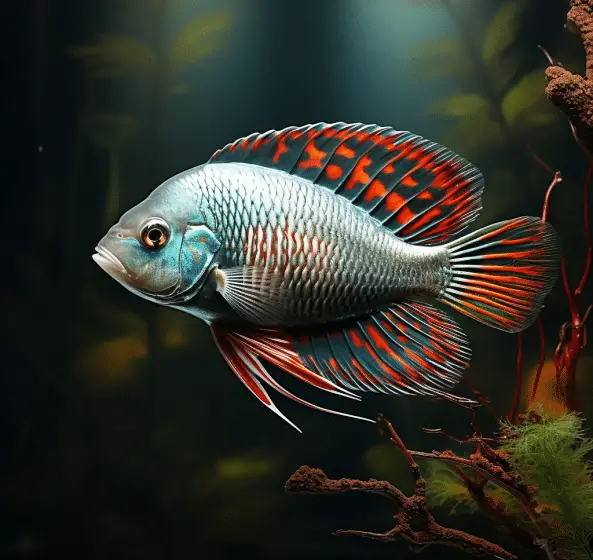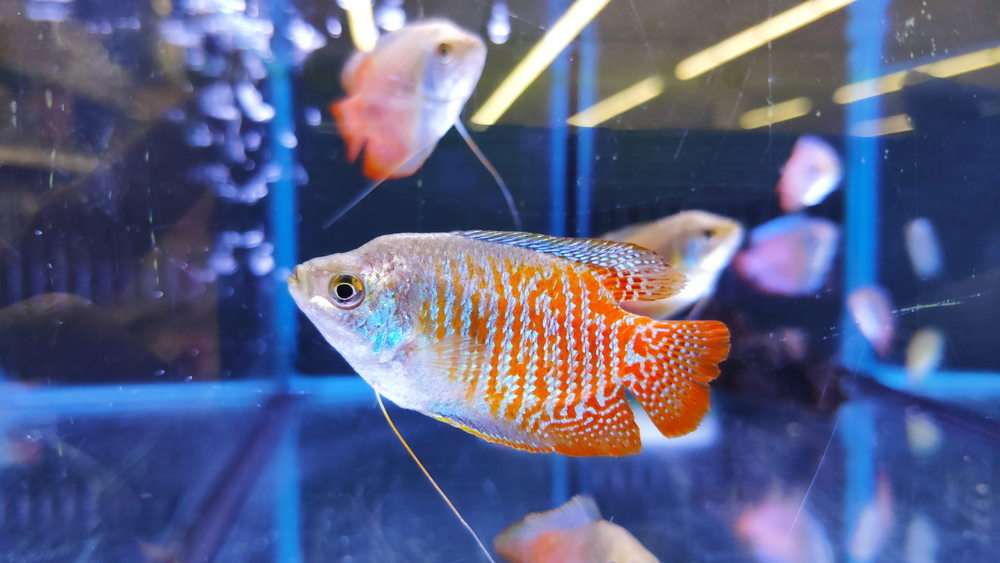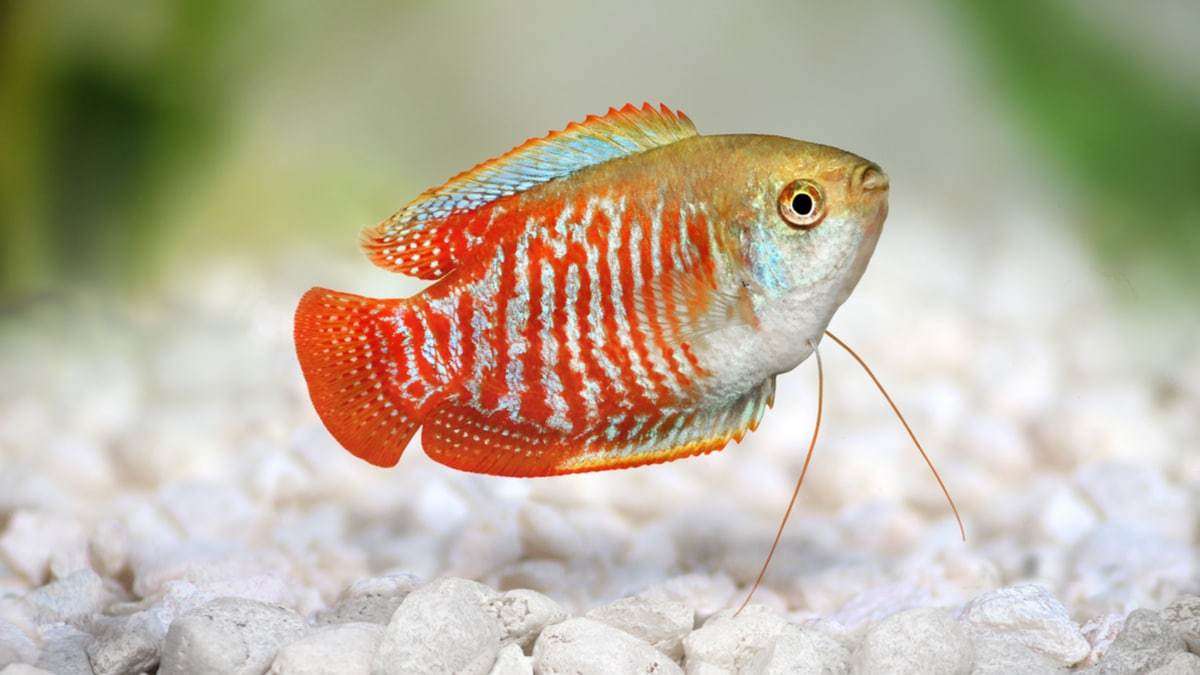How Many Gouramis Should Be Kept Together

Introduction
How Many Gouramis Should Be Kept Together: Keeping Gouramis in an aquarium fish is a delightful experience for many aquarists. These vibrant, labyrinth fish, known for their dazzling colors and unique personalities, have become a popular choice among fish enthusiasts.
Type, tank size, water conditions, and fish personalities impact how many Gouramis you can keep in an aquarium.
We will discuss the most significant factors to consider when choosing how many Gouramis to keep in your tank. Talk about Gourami types and how they get along. We’ll also offer Gourami community happiness and wellness suggestions. For the best results and fun, you should know how many Gouramis to keep together, whether you’re a newbie starting a tank or an expert aquarist improving your present setup.

Can 3 gouramis live together?
A single honey gourami can live in a 5- or 10-gallon tank, but a group of three gouramis would do better in a 20-gallon aquarium. Honey gouramis live in sluggish waters, so use a filter with slower flow. Are honey gouramis aggressive? No, they are considered to be peaceful community fish that get along with everyone.
Can three Gouramis live together in the same aquarium? The answer largely depends on several crucial factors. First and foremost, the species of Gouramis you intend to keep plays a significant role. Some Gourami species are more territorial and aggressive than others, making them less suitable for cohabitation in smaller groups. Peaceful species like the Honey Gourami or Dwarf Gourami are generally more amenable to group living.
Another vital consideration is the size of your aquarium. Gouramis, like most fish, require adequate space to establish territories and minimize territorial disputes. A larger tank with plenty of hiding spots and plants can accommodate a trio of Gouramis more comfortably than a smaller one.
Gouramis are sensitive to fluctuations in water conditions, so maintaining a stable and well-maintained environment is essential for their health and harmony in a group.
Lastly, individual Gourami personalities matter. Some fish are more docile, while others can be more aggressive. When introducing three Gouramis into the same tank, closely monitor their interactions to ensure they coexist peacefully. If you observe signs of aggression or stress, be prepared to separate them or adjust the tank setup.
It is possible for three Gouramis to live together, but it requires careful consideration of species, tank size, water conditions, and the individual temperament of the fish to ensure a harmonious and healthy cohabitation.
Can you keep multiple gouramis together?
Male gouramis have a tendency to be aggressive towards each other, so they should typically be kept individually. Female gouramis usually tolerate each other well. Mixing different species or color varieties of gouramis should only be done in larger, well decorated tanks.
Keeping multiple gouramis together in an aquarium is possible, but it requires careful consideration of factors like tank size, compatibility, and adequate hiding spots. Gouramis are a popular freshwater fish species known for their vibrant colors and unique personalities. While they can coexist, it’s essential to choose species that are compatible in terms of size, temperament, and water parameters.
For example, dwarf gouramis are generally peaceful and can be kept together in a well-maintained tank. However, larger species like pearl or kissing gouramis may become territorial, especially in smaller setups.
Keeping a tank that is big enough for multiple gouramis is very important. The tank should be the right size for the number and type of gouramis you want to keep. Guramis are very sensitive to changes in water conditions, so it’s important to keep the water clean by filtering it well and changing it often.
For a peaceful community tank, you should watch how your gouramis act and be ready to separate them if they get aggressive. Keeping several gouramis together can make for a beautiful and peaceful aquarium if you plan ahead and pay attention to their needs.
Is it OK to have one dwarf gourami?
Even if you only get one dwarf gourami, they are kind of similar to betta fish where it comes down to the individual’s personality on whether or not it can live in a community tank.
Is it okay to have one Dwarf Gourami in your aquarium? While it’s possible to keep a single Dwarf Gourami, there are several important factors to consider before making this decision.
Dwarf Gouramis are social creatures and generally thrive better when kept in pairs or small groups. They display more natural behaviors and are less stressed when they have companions of their own kind. However, if you choose to keep just one Dwarf Gourami, you must ensure that it doesn’t feel lonely. Providing plenty of hiding spots, plants, and other tankmates can help alleviate potential isolation.
It’s important to be aware that Dwarf Gouramis, like their larger Gourami relatives, can be territorial and occasionally aggressive, particularly towards members of the same species. To mitigate this, ensure the tank is adequately sized and contains suitable decorations to break sightlines and provide refuge. Regular observation is essential to monitor the Gourami’s behavior and adjust the tank setup if necessary.
While it’s possible to keep a single Dwarf Gourami, it’s generally more beneficial for their well-being to have at least one companion. However, with careful attention to their environment and social needs, a solitary Dwarf Gourami can still lead a healthy and content life in your aquarium.
Can I keep a single gourami?
They’re naturally shy, so if they’re kept alone they’re likely to become timid and spend their days hiding away. A large group of males in the same tank can be territorial, but this can be remedied by keeping them in a large aquarium where they can stake out their own space.
It is possible to keep a single Gourami, but it comes with certain considerations. Gouramis are generally social fish, and they thrive better when kept in pairs or small groups, as this allows them to display more natural behaviors and reduce stress. However, there are circumstances where keeping a solitary Gourami can be appropriate.
First, the individual temperament of the Gourami matters. Some Gouramis may be more solitary by nature and less prone to stress or aggression when alone. Observing your Gourami’s behavior can help determine if it is comfortable as a single fish.
Second, the size of your aquarium is critical. A larger tank provides more space for a single Gourami to establish its territory and reduces the risk of territorial conflicts with other fish. In a smaller tank, a single Gourami may be more stressed due to limited space.
Lastly, you can alleviate potential loneliness by providing ample hiding spots, plants, and other tank decorations. The presence of tankmates that are compatible with Gouramis can also reduce feelings of isolation.
How can you tell if a gourami is male or female?
Male and Female Gouramis
The dorsal fin of the female is short and rounded, while the male has a longer dorsal fin that comes to a point. Keep in mind that young fish are not as easy to differentiate as full grown adults. In younger fish, the fins are not fully developed and they have not attained their adult size.
Determining the gender of Gouramis can be a bit challenging, but there are some key physical and behavioral traits that can help you distinguish between males and females. Here’s how you can tell if a Gourami is male or female:
- Fin Differences: One of the most noticeable distinctions is the dorsal fin. In many Gourami species, males have a more elongated and pointed dorsal fin, while females have shorter and rounder dorsal fins. This difference is often pronounced during the breeding season when males’ dorsal fins become more extended.
- Coloration: In some species, males are more brightly colored than females. They may have vibrant and iridescent patterns, while females tend to have more subdued coloring. However, this can vary between different Gourami species.
- Body Shape: Males may have a sleeker and more streamlined body shape, while females can appear slightly rounder or plumper, especially when they are carrying eggs.
- Behavior: During the breeding season, males tend to become more territorial and may exhibit more aggressive and territorial behaviors as they prepare for courtship.
- Egg Spot: Some Gourami species have a small, dark spot near the anal fin. This spot is more prominent in females and is used during the breeding process.
It’s helpful to research the specific species you are keeping for more accurate gender identification. Additionally, juvenile Gouramis may not display these traits until they reach sexual maturity.
How many gouramis can I keep in the same tank?
The kind of gourami, tank size, and hiding locations determine how many you can keep in a tank. A small group of peaceful gouramis like dwarf gouramis can live together in a well-maintained aquarium with hiding places and space. Three to five dwarf gouramis can cohabit in a 20- to 30-gallon tank.
These species can be territorial and need 50-gallon tanks or more. To build territories and reduce conflicts, species must have enough trees, rocks, and caves to hide. Purification and water changes are also necessary for gourami health.
The most important thing is to investigate the gourami species you want to preserve and establish a social and territorial environment.
Can I mix different species of gouramis in the same tank?
Mixing different species of gouramis in the same tank can be challenging and requires careful consideration. While it is possible, there are important factors to keep in mind. Gouramis can be territorial, especially when breeding, so choosing species with similar temperaments is crucial.
Dwarf gouramis, for example, are generally more peaceful and can coexist with other small, non-aggressive species. However, mixing larger species like pearl gouramis or paradise gouramis may lead to territorial disputes, particularly in smaller tanks.
Hideouts and visual obstacles like plants or decorations can help divide areas and prevent violence. Monitoring gourami behavior and being ready to remove them if aggressiveness occurs is also crucial.
Additionally, having a sufficiently large tank is crucial when keeping multiple species of gouramis together. This allows for more space and reduces the likelihood of territorial issues.
Mixing gourami species in a tank takes careful planning, monitoring, and a large tank with enough hiding spots to ensure harmony.
Can I keep gouramis with other fish species?
Yes, it is possible to keep gouramis with other fish species, but it’s important to choose tankmates carefully to ensure compatibility. Gouramis are generally peaceful fish, but they can be territorial, especially during breeding periods.
Some suitable tankmates for gouramis include tetras, rasboras, danios, and peaceful bottom-dwelling species like corydoras or loaches. Livebearers like guppies or mollies can also coexist well with gouramis.
Pairing gouramis with aggressive or fin-nipping species might stress and injure them. Monitoring tank dynamics and being ready to intervene if aggression or stress occur are also crucial.
Provide enough hiding spaces and plants to develop territories and avoid tankmate fighting. For the community’s fish to thrive, an aquarium with proper filtration and water changes is required.
Create a peaceful and attractive community tank with gouramis and other fish by carefully selecting compatible species and creating an appropriate environment.

Conclusion
The species, tank size, water conditions, and individual fish personalities all play a crucial role in determining the right number for your specific setup.
While there is no one-size-fits-all answer, it’s essential to prioritize the well-being and happiness of your Gouramis. Ensuring they have sufficient space, suitable tank mates, and a stable environment is paramount to their health and longevity. Overcrowding can lead to stress, aggression, and ultimately, a less enjoyable hobby.
Throughout this guide, we’ve explored the characteristics and compatibility of various Gourami species, helping you make informed decisions about your aquatic community. By understanding the unique requirements of your Gouramis and providing them with a comfortable and stress-free environment, you can create a thriving and visually captivating aquarium.
Remember that regular observation and ongoing adjustments to your Gourami tank are key to success. Tailoring your approach to the specific needs of your fish will lead to a harmonious aquatic ecosystem and a rewarding experience for both novice and experienced aquarists. Keep in mind that successful Gourami keeping ultimately involves finding the right balance for your unique aquarium.



